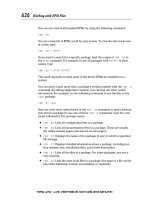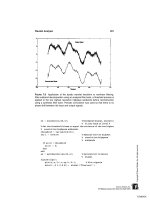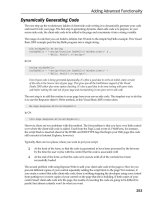Financial Toolbox For Use with MATLAB Computation Visualization Programming phần 7 docx
Bạn đang xem bản rút gọn của tài liệu. Xem và tải ngay bản đầy đủ của tài liệu tại đây (161.09 KB, 40 trang )
fwd2zero
2-142
2fwd2zero
Purpose Zero curve given a forward curve.
Syntax [zr, cd] = fwd2zero(fr, cd, sd, ocomp, obasis, icomp, ibasis)
[zr, cd] = fwd2zero(fr, cd, sd, ocomp, obasis, icomp)
[zr, cd] = fwd2zero(fr, cd, sd, ocomp, obasis)
[zr, cd] = fwd2zero(fr, cd, sd, ocomp)
[zr, cd] = fwd2zero(fr, cd, sd)
Arguments fr Forward rates. An N-by-1 vector of annualized implied forward rates,
as decimal fract ions. In aggregate, the rates in
fr constitute an
implied forward curve for the investment horizon represented by
cd.
cd Curve dates. An N-by-1 vector of maturity dates (as serial date
numbers) that correspond to the forward rates in
fr.Usedatenum to
convert date strings to serial date numbers.
sd Settlement date. A serial date number that is the common settlement
date for the forward rates in
fr.
ocomp Output compounding. A scalar that sets the compounding frequency
per year for annualizing the output zero rates in
zr. Allowed values
are:
1 = annual compounding
2 = semi-annual compounding (default)
3 = compounding three times per year
4 = quarterly compounding
6 = bimonthly compounding
12 =monthlycompounding
365 = daily compounding
−
1 = continuous compounding
obasis Output day-count basis for annualizing the output zero rates in zr.
0 = actual/actual (default), 1 = 30/360, 2 = actual/360, 3 = actual/365.
icomp Input compounding. A scalar that indicates t he compounding
frequency per year used for annualizing the input forward rates in
fr.
Allowed values are the same as for
ocomp. Default = ocomp.
ibasis Input day-count basis used for annualizing the forward rates in fr.
Allowed values are the same as for
obasis. Default = obasis.
fwd2zero
2-143
Description [zr, cd] = fwd2zero(fr, cd, sd, ocomp, obasis, icomp, ibasis)
returns a zero curve given an implied forward curve and its maturity dates.
zr Zero rates. An N-by-1 vector of d ecimal fractions. In aggregate, the rates
in
zr constitute a zero curve for the investment horizon represented by cd.
cd Curve dates. An N-by-1 vector of maturity dates (as serial date numbers)
that correspond to the zero rates in
zr. This vector is the same as the
input vector
cd.Usedatestr to convert serial date numbers to date
strings.
Example Givenanimpliedforwardcurvefr over a set of maturity dates cd,anda
settlement date
sd:
fr = [0.0469
0.0519
0.0549
0.0535
0.0558
0.0508
0.0560
0.0545
0.0615
0.0486];
cd = [datenum('06-Nov-1997')
datenum('11-Dec-1997')
datenum('15-Jan-1998')
datenum('05-Feb-1998')
datenum('04-Mar-1998')
datenum('02-Apr-1998')
datenum('30-Apr-1998')
datenum('25-Jun-1998')
datenum('04-Sep-1998')
datenum('12-Nov-1998')];
sd = datenum('03-Nov-1997');
fwd2zero
2-144
Set daily compounding for the zero curve, on an actual/365 basis. The forward
curve was compounded annually on an actual/actual basis.
ocomp = 365;
obasis = 3;
icomp = 1;
ibasis = 0;
Execute the function
[zr, cd] = fwd2zero(fr, cd, sd, ocomp, obasis, icomp, ibasis)
which returns the zero curve zr at the maturity dates cd:
zr =
0.0458
0.0502
0.0518
0.0518
0.0524
0.0518
0.0523
0.0525
0.0541
0.0529
cd =
729700
729735
729770
729791
729818
729847
729875
729931
730002
730071
(For readability, fr and zr are shown here only to the basis point. However,
MATLAB computed them at full precision. If you enter
fr as shown, zr may
differ due to rounding.)
See Also zero2fwd and other functions for Term Structure of Interest Rates
highlow
2-145
2highlow
Purpose High,low,open,closechart.
Syntax highlow(hi, lo, cl, op, color)
highlow(hi, lo, cl, op)
highlow(hi, lo, cl)
highlow(hi, lo, cl, [], color)
h = highlow(hi, lo, cl, op, color)
Arguments hi High prices for a security. An N-by-1 vector.
lo Low prices for a s ecurity. An N-by-1 vector.
cl Closing prices for a security. An N-by-1 vector.
op Opening prices for a security. An N-by-1 vector. Optional. To specify
color when op is unknown, enter op as an empty matrix [].
color Vertical line color. A string. MATLAB supplies a default color if none is
specified. The default color differs depending on the background color of
the figure window. See “ColorSpec” in the online MATLAB Help Desk
for
color names.
Description highlow(hi, lo, cl, op, color) plots the high, low, opening, and closing
prices of an asset. Plots are vertical lines whose top is the high, bottom is the
low, open is a short horizontal tick to the left, and close is a s hort horizontal
tick to the right.
h = highlow(hi, lo, cl, op, color) plots the figure and returns the
handles
h of the lines. See Using MATLAB Graphics for information on
graphics and object handles.
Example The high, low, and closing prices for an asset are stored in equal-length vectors
assethi, assetlo,andassetcl respectively
highlow(assethi, assetlo, assetcl, [], 'cyan')
plots the price data using cyan lines.
See Also bolling, candle, dateaxis, movavg, pointfig
holidays
2-146
2holidays
Purpose Holidays and non-trading days.
Syntax h = holidays(d1, d2)
h = holidays
Description h = holidays(d1, d2) returns a vector h of serial date numbers
corresponding to th e holidays and non-trading days between dates
d1 and d2,
inclusive. Enter
d1 and d2 as serial dat e numbers or date strings.
h = holidays returns a vector h of serial date numbers corresponding to all
holidays and non-trading days.
As shipped, this function contains all holidays and special non-trading days for
the New York Stock Exchange between 1950 and 2030, inclusive (681 dates).
You can edit the
holidays.m file to contain your own holidays and non-trading
days. By definition, holidays and non-trading days are those that occur on
weekdays.
Example h = holidays('jan 1 1997', 'jun 23 1997') returns
h =
729391
729438
729477
729536
which are the s erial date numbers for
01-Jan-1997 New Year's Day
17-Feb-1997 Washington's Birthday
28-Mar-1997 Good Friday
26-May-1997 Memorial Day
See Also busdate, fbusdate, isbusday, lbusdate
hour
2-147
2hour
Purpose Hour of date or time.
Syntax h = hour(d)
Description h = hour(d) returns the hour of the day given a serial date number or a date
string
d.
Example h = hour(728647.5590548427)
or
h = hour('19-dec-1994, 13:24:08.17')
returns
h =
13
See Also datevec, minute, second
irr
2-148
2irr
Purpose Internal rate of return.
Syntax r = irr(cf)
Description r = irr(cf) calculates the internal rate of return for a series of periodic cash
flows.
cf is the cash flow vector. The first entry in cf is the initial investment.
If the cash flow p ayments are monthly, multiply the resulting rate of return b y
12 for the annual rate of return. This function calculates only positive rates of
return; for negative rates of return,
r = NaN.
Example This cash flow represents the yearly income from an initial investment of
$100,000:
To calculate the internal rate of ret urn on t he investment:
r = irr([−100000 10000 20000 30000 40000 50000])
returns
r =
0.1201
(12.01%)
See Also effrr, mirr, nomrr, taxedrr, xirr
Reference Brealey and Myers , Principles of Corporate Finance,Chapter5
Year 1 $10,000
Year 2 $20,000
Year 3 $30,000
Year 4 $40,000
Year 5 $50,000
isbusday
2-149
2isbusday
Purpose True for dates that are business days.
Syntax t = isbusday(d, hol)
t = isbusday(d)
Arguments d Date(s) being checked. Enter as a serial date number or date string. d can
contain multiple dates, but they must all be in the same forma t.
hol Vector of holidays and non-trading-day dates. All dates in hol must be the
same format: either serial date numbers or date strings. (Using date
numbers improves performance.) The
holidays function supplies the
default vector.
Description t = isbusday(d, hol) returns logical true (1)ifdis a business day and
logical false (
0)otherwise.
Examples t = isbusday('15 jun 1997')
t =
0
d = ['15 feb 98'; '16 feb 98'; '17 feb 98'];
t = isbusday(d)
t =
0
0
1
See Also busdate, fbusdate, holidays, lbusdate
lbusdate
2-150
2lbusdate
Purpose Last business date of month.
Syntax d = lbusdate(y, m, hol)
d = lbusdate(y, m)
Arguments y Year. Enter as four-digit integer.
m Month. Enter as integer from 1 to 12.
hol Vector of holidays and non-trading-day dates. All dat es in hol must be the
same format: either serial date numbers or date strings. (Using d ate
numbers improves performance.) The
holidays fu n ction s u p plies the
default vector.
Description d = lbusdate(y, m, hol) returns the serial date number for the last
business date of the given year
y and month m where hol specifie s non-trading
days.
y and m can contain multiple values. If one contains multiple values, the other
must contain the same number of values or a single value that applies to all.
For example, if
y isa1-by-Nvectorofintegers,themmmust be a 1-by-N vector
of integers or a single integer.
d is then a 1-by-N vector of date numbers.
Use the function
datestr t o convert serial date numbers to formatted date
strings.
Examples d = lbusdate(1997, 5)
d =
729540
datestr(d)
ans =
30-May-1997
y = [1997 1998 1999];
d = lbusdate(y, 5); datestr(d)
ans =
30-May-1997
29-May-1998
28-May-1999
See Also busdate, eomdate, fbusdate, holidays, isbusday
lweekdate
2-151
2lweekdate
Purpose Date of last occurrence of weekday in month.
Syntax d = lweekdate(wkd, y, m, g)
d = lweekdate(wkd, y, m)
Arguments wkd Weekday whose date you seek. Enter as an integer from 1 through 7:
1 Sunday
2 Monday
3 Tuesday
4 Wednesday
5 Thursday
6 Friday
7 Saturday
y Year. Enter as a four-digit integer.
m Month. Enter as an integer from 1 through 12.
g Weekday that must occur after wkd in the same week. Enter as an integer
from
0 through 7,where0= ignore (default) and 1 through 7 are as for wkd.
Description d = lweekdate(wkd, y, m, g) returns the serial date number for the last
occurrence of t he weekday
wkd in the given year y and month m,andinaweek
that also contains the weekday
g.
Any input can contain multiple values, but if so, all other inputs must contain
the same number of values or a single value that applies to all. For example,
if
y isa1-by-Nvectorofintegers,thenmmust be a 1-by-N vector of integers or
asingleinteger.
dis then a 1-by-N vector of date numbers.
Use the function
datestr to convert serial date numbers to formatted date
strings.
Examples To find the last Monday in June 1997:
d = lweekdate(2, 1997, 6); datestr(d)
ans =
30-Jun-1997
lweekdate
2-152
To find the last Monday in a week that also contains a Friday in June 1997:
d = lweekdate(2, 1997, 6, 6); datestr(d)
ans =
23-Jun-1997
To find the last Monday in May for 1997, 1998, and 1999:
y = [1997:1999];
d = lweekdate(2, y, 5)
d =
729536 729900 730271
datestr(d)
ans =
26-May-1997
25-May-1998
31-May-1999
See Also eomdate, lbusdate, nweekdate
m2xdate
2-153
2m2xdate
Purpose MATLAB serial date number to Excel serial date number.
Syntax xd = m2xdate(d, dsys)
xd = m2xdate(d)
Arguments d MATLAB serial date number. A vector or scalar.
dsys Excel date system. A vector or scalar.
0 = 1900 date system (default), in which 1 = January 1, 1900 A.D.
1 = 1904 dat e system, in which 0 = January 1, 1904 A.D.
Vector arguments must have consistent dimensions.
Description xd = m2xdate(d, dsys) converts MATLAB serial date numbers d to Excel
serial date numbers
xd. MATLAB date numbers start with 1 = January 1, 0000
A.D., hence there is a difference of 693960 relative to the 1900 date system, or
695422 relative to the 1904 date syste m. This function is use ful with MATLAB
Excel Link.
Example Given MATLAB date numbers for Christmas 1 997 through 2000:
d = datenum(1997:2000, 12, 25)
d =
729749 730114 730479 730845
convert them to Excel date numbers in the 1904 s ystem:
xd = m2xdate(d, 1)
xd =
34327 34692 35057 35423
or the 1900 system:
xd = m2xdate(d)
xd =
35789 36154 36519 36885
See Also datenum, datestr, x2mdate
minute
2-154
2minute
Purpose Minuteofdateortime.
Syntax m = minute(d)
Description m = minute(d) returns the minute given a serial date number or a date string
d.
Example m = minute(728647.559054842)
or
m = minute('19-dec-1994, 13:25:08.17')
returns
m =
25
See Also datevec, hour, second
mirr
2-155
2mirr
Purpose Modified internal rate of ret u rn.
Syntax r = mirr(cf, srate, rrate)
Arguments cf Vector of cash flows. The first entry in cf is the initial investment.
srate Finance rate for negative cash flow values. Enter as decimal fraction.
rrate Reinvestment rate for positive cash flow values, as a decimal fraction.
Description r = mirr(cf, srate, rrate) calculates the modified internal rate of return
for a series of periodic cash flows. This function calculates only positive rates
of return; for negative rates of return,
r = 0.
Example This cash flow represents the yearly income from an initial investment of
$100,000. The finance rate is 9% and the reinvestment rate is 12%.
To calculate the modified internal rate of return on the investment:
r = mirr([−100000 20000 −10000 30000 38000 50000], 0.09, 0.12)
returns
r =
0.0832
(8.32%)
See Also annurate, effrr, irr, nomrr, pvvar, xirr
Reference Brealey and Myers, Principles of Corporate Finance,Chapter5
Year 1 $20,000
Year 2 ($10,000)
Year 3 $30,000
Year 4 $38,000
Year 5 $50,000
month
2-156
2month
Purpose Monthofdate.
Syntax [n, m] = month(d)
Description [n, m] = month(d) returns the month in numeric n and string form m given
a serial date number or a date string
d.
Example [n, m] = month(728647)
or
[n, m] = month('19-dec-1994')
returns
n =
12
m =
Dec
See Also datevec, day, year
months
2-157
2months
Purpose Number of whole months between dates.
Syntax mm = months(d1, d2, eom)
mm = months(d1, d2)
Description mm = months(d1, d2, eom) returns the number of whole months between
two dates
d1 and d2.Ifd2 is earlier than d1, mm is negative. Enter dates as
serial date numbers or date strings.
eom is the end-of-month flag. If d1 and d2 are end-of-month dates and d2 has
fewer days than
d1, eom = 1 (default) treats d2 as the end of a whole month,
while
eom = 0 does not.
Any input argument can contain multiple values, but if so, all other inputs
must contain the same number of values or a single value that applies to all.
For example, if
d1 is an N-row charact er array of date strings, then d2 must b e
an N-row character array of date strings or a single date.
mm is then an N-by-1
vector of numbers.
Examples mm = months('may 31 1997', 'jun 30 1997', 1)
mm =
1
mm = months('may 31 1997','jun 30 1997', 0)
mm =
0
d1 = ['mar 31 1997'; 'apr 30 1997'; 'may 31 1997'];
mm = months(d1, 'jun 30 1997')
mm =
3
2
1
See Also yearfrac
movavg
2-158
2movavg
Purpose Leading and lagging moving averages chart.
Syntax movavg(asset, lead, lag, alpha)
movavg(asset, lead, lag)
[short, long] = movavg(asset, lead, lag, alpha)
Arguments asset Security data, usually a vector of time-series prices.
lead Number of samples to use in leading average calculation. A positive
integer.
lead must be less than or equal to lag.
lag Number of samples to use in the lagging average calculation. A positive
integer.
alpha Control parameter that determines the type of moving averages.
0 = simple moving average (default), 0.5 = square root weighted moving
average,
1 =linearmovingaverage,2= square weighted moving
average, etc. To calculate the exponential moving average, set
alpha ='e'.
Description movavg(asset, lead, lag, alpha) plots leading and la gging moving
averages.
[short, long] = movavg(asset, lead, lag, alpha) returns the leading
short and lagging long moving average data without plotting it.
Example If asset is a vector of stock price data:
movavg(asset, 3, 20, 1)
plots linear three-sample leading and 20-sample lagging moving averages.
See Also bolling, candle, dateaxis, highlow, pointfig
nomrr
2-159
2nomrr
Purpose Nominal rate of return.
Syntax apr = nomrr(er, per)
Arguments er Effective annual percentage rate. Enter as a decimal fraction.
per Number of compounding periods per year, an integer.
Description apr = nomrr(er, per) calculates the nominal rate of return.
Example To find the nominal annual rate of return based on an effective annual
percentage rate of 9.38% compounded monthly:
apr = nomrr(0.0938, 12)
returns
apr =
0.0900
(9.0%)
See Also effrr, irr, mirr, taxedrr, xirr
now
2-160
2now
Purpose Current date and time.
Syntax t = now
Description t = now returns the current date and time as a serial date numb er.
Note: This function now ships with basic MATLAB. It originally shipped
only w ith the Fina ncial Toolbox, and thi s description remains here for yo u r
convenience.
Example t = now
t =
729647.5833
(on September 14, 1997 at 2:00 PM)
See Also date, datenum, today
nweekdate
2-161
2nweekdate
Purpose Date of specific occurrence of weekday in month.
Syntax d = nweekdate(n, wkd, y, m, g)
d = nweekdate(n, wkd, y, m)
Arguments n Nth occurrence of the weekday in a month. Enter as a n integer from 1
through 5.
wkd Weekday whose date you seek. Enter as an integer from 1 through 7:
1 Sunday
2 Monday
3 Tuesday
4 Wednesday
5 Thursday
6 Friday
7 Saturday
y Year. Enter as a four-digit integer.
m Month. Enter as an integer from 1 through 12.
g Weekday that must occur in the same week with wkd. Enter as an integer
from
0 through 7,where0= ignore (default) and 1 through 7 are as for wkd.
Description d = nweekdate(n, wkd, y, m, g) returns the serial date number for the
specific occurrence of the weekday
wkd in the given year y and month m,andin
a week that also contains the weekday
g.
If
n is larger than the last occurrence of wkd, d = 0.
Any input can contain multiple values, but if so, all other inputs must contain
the same number of values or a single value that applies to all. For example,
if
y isa1-by-Nvectorofintegers,thenmmust be a 1-by-N vector of integers or
asingleinteger.
dis then a 1-by-N vector of date numbers.
Use the function
datestr to convert serial date numbers to formatted date
strings.
nweekdate
2-162
Examples To find the first Thursday in May 1997:
d = nweekdate(1, 5, 1997, 5); datestr(d)
ans =
01-May-1997
To find the first Thursday in a week that also contains a Wednesday in May
1997:
d = nweekdate(1, 5, 1997, 5, 4); datestr(d)
ans =
08-May-1997
To find the third Monday in February for 1997, 1998, and 1999:
y = [1997:1999];
d = nweekdate(3, 2, y, 2)
d =
729438 729802 730166
datestr(d)
ans =
17-Feb-1997
16-Feb-1998
15-Feb-1999
See Also fbusdate, lbusdate, lweekdate
opprofit
2-163
2opprofit
Purpose Option profit.
Syntax p = opprofit(so, x, cost, flag, type)
Arguments so Asset price.
x Strike or exercise price.
cost Cost of the option.
flag Option position. 0 =long, 1=short.
type Option type. 0 =calloption,1= put option.
Description p = opprofit(so, x, cost, flag, type) returns the profit of an option.
Example Buying (going long on) a call option with a strike price of $90 on an underlying
asset with a current price of $100 for a cost of $4:
p = opprofit(100, 90, 4, 0, 0)
returns
p =
6.00
a profit of $6 if the option is exercised under these conditions.
See Also binprice, blsprice
payadv
2-164
2payadv
Purpose Periodic payment given number of a dvance payments.
Syntax pmt = payadv(rate, nper, pv, fv, adv)
Arguments rate Lending or borrowing rate per period. Enter as a decimal fraction.
Must be greater than or equal to 0.
nper Number of periods in the life of the instrument.
pv Present value of the instrument.
fv Future value or target value to be attained after nper periods.
adv Number of advance payments. If the payments are made at the
beginning of the period, add
1 to adv.
Description pmt = payadv(rate, nper, pv, fv, adv) returns the periodic payment
given a number of advance payments.
Example The present value of a loan is $1000.00 and it will be paid in full in 12 months.
The annual interest rate i s 10% and three payments are made at closing time.
Using this data:
pmt = payadv(0.1/12, 12, 1000, 0, 3)
returns
pmt =
85.94
for the periodic payment.
See Also amortize, payodd, payper
payodd
2-165
2payodd
Purpose Payment of loan or annuity with odd first period.
Syntax pmt = payodd(rate, nper, pv, fv, dys)
Arguments rate Interest rate per period. Enter as a decimal fraction.
nper Number of periods in t he l ife of the instrument.
pv Present value of the instrument.
fv Future value or target value to be attained after nper periods.
dys Actual number of days until the first payment is made.
Description pmt = payodd(rate, nper, pv, fv, dys) returns the payment for a loan or
annuity with an odd first period.
Example A two-year loan for $4000 has an annual interest rate of 11%. The first
payment will be made in 36 days. To find the monthly payment:
pmt = payodd(0.11/12, 24, 4000, 0, 36)
returns
pmt =
186.77
See Also amortize, payadv, payper
payper
2-166
2payper
Purpose Periodic payment of loan or annuity.
Syntax pmt = payper(rate, nper, pv, fv, due)
pmt = payper(rate, nper, pv, fv)
pmt = payper(rate, nper, pv)
Arguments rate Interest rate per period. Enter as a decimal fraction.
nper Number of payment periods in the life of the instrument.
pv Present value of the instrument.
fv Future value or remaining balance after nper periods. Default = 0.
due When payments are due: 0 = end of period (default), or 1 = beginning of
period.
Description pmt = payper(rate, nper, pv, fv, due) returns the periodic payment of a
loan or annuit y .
Example Find the monthly payment for a three-year loan of $9000 with an annual
interest rate of 11.75%:
pmt = payper(0.1175/12, 36, 9000, 0, 0)
returns
pmt =
297.86
See Also amortize, fvfix, payadv, payodd, pvfix









